Engineering a Boom: The Second Boom
Lacking the necessary conditions to incite a boom, the oil shale industry and the federal government maintained a concerted and continual effort for an oil shale revival throughout the middle part of the 20th century. The potential was too big to ignore. Both the industry and the government continued to sponsor research into oil shale but the industry could not compete with the easily accessible, free-flowing crude oil found in the Middle East. Oil prices remained somewhat stagnant and although interest increased during World War II, the next boom would not come until the 1970’s, when all three factors worked in cohesion to bring upon the most significant oil shale boom in Shale Country.
Waiting for the Next Boom
Despite the failure of the first boom cycle to produce a single drop of oil out of Shale Country, the lore of the vast resource and potential wealth kept the nascent industry from disappearing. Interest in oil shale grew again during World War II, as petroleum shortages encouraged the search for domestically plentiful alternative fuels. In 1944, Congress passed the Synthetic Liquid Fuels Act, authorizing the establishment of federal demonstration facilities to produce synthetic fuel (an engineered substitute for oil) from coal, oil shale, biomass, and anything else that might power American tanks, ships, airplanes, and automobiles. Pursuant to the act, the Bureau of Mines opened a new research facility at Anvil Points, near the old Rulison Project, and experimented with a variety of oil shale mining and retorting methods.
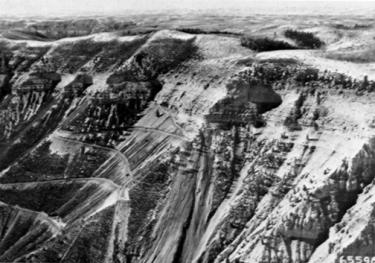
In 1952, President Harry Truman partially cleared the way for an industry revival by lifting Hoover’s order and allowing the Department of Interior to entertain bids for the lease of oil shale lands. However, Interior officials were still wary of exploitation by speculators, some of whom the department was challenging in court over the validity of their claims. With these reservations and without proven technology to successfully develop the shale resources, Secretary Oscar Chapman, a Coloradan, declined to open the land for leasing. Congress dealt the final blow to hopes of the resurgence of oil shale in 1956 when it suspended funding for the Anvil Points facility. Unlike earlier in the century, federal interest had this time failed to prompt a commercial shale boom. But many of the basic mining methods and equipment designs developed at Anvil Points became the industry standard (albeit with some technological improvements) when a new boom did come to the Western Slope over a decade later. 1
Opportunity Arrives
Beginning in 1973 and stretching into 1974, the Arab Oil Embargo reinvigorated interest in oil shale. The embargo caused oil prices to skyrocket and President Richard Nixon responded to the embargo by outlining Project Independence, a plan to free the nation from foreign energy sources by the end of the decade. Interest in domestic energy sources surged, and boosters quickly portrayed oil shale “as an ace in the hole for national security.”
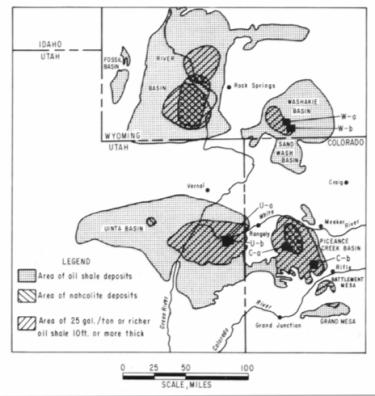
Five years earlier, when the Department of the Interior had offered 3 oil shale tracts for sale in 1968, the leases attracted little attention from the major oil shale companies. Responding to the tireless boosterism of energy companies and oil shale advocates and hoping to assuage the public’s perpetual anxieties about the domestic energy supply, Stewart Udall exercised his authority as Secretary of the Interior to offer 3 federally owned tracts of oil shale land for lease. However, the boosters had overhyped the appeal of their potential product (or, perhaps, were just a few years too far ahead of their time). The limited private lands already available were sufficient for the inchoate industry at the time, and this offering attracted little attention from the big energy companies that provided most of the nation’s oil.

In the midst of the Arab Oil Embargo, when the Interior offered 6 more federally owned tracts in 1974 – two each in Colorado, Utah, and Wyoming at more than 5000 acres apiece – this time around those in Colorado and Utah attracted considerable attention. The site dubbed C-a (as in “Colorado tract A”) in Rio Blanco County drew the most interest, receiving 7 sealed bids that averaged $91.6 million and topped out with a winning bid of over $210 million – at the time the highest per-acre price ever paid for a federal energy lease. 2
A False Start
Development got off to a slow start as the winning companies moved into the planning and design process. Some of the delay arose from the fact that, before they could get shovels in the ground, the companies had to gather baseline environmental data to comply with the slew of new environmental laws recently adopted by Congress – the Wilderness Act in 1964, the Clean Air Act in 1970, the National Environmental Policy Act (NEPA) in 1970, the Clean Water Act in 1972, the Endangered Species Act in 1973, and the Safe Drinking Water Act in 1974. Furthermore, any operations beginning on BLM lands after 1976 would also have to meet the requirements of that year’s Federal Lands Policy and Management Act (FLPMA), which compels the agency to develop land use plans that accommodate multiple uses and protect the scenic qualities of the landscape.
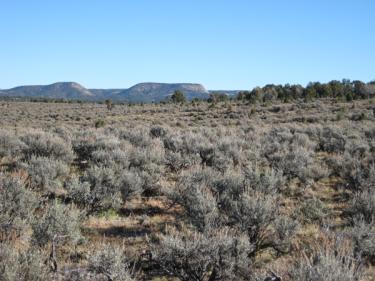
Whether these new regulations, economic fluctuations, the old technological difficulties, or (most likely) a combination of factors were responsible, by 1976 oil shale development seemed more boink than boom. The embargo-induced energy crisis had abated, inflation was up, lessees had started requesting a suspension of their leases until the situation changed for the better, two companies had given up their leases entirely (although they maintained other private holdings in the area), and the industry’s outlook was generally sour. Even the official industry magazine, Shale Country, folded up. 3 As in the decade after World War II, it seemed that the industry had gotten off to another false start. Even as domestic oil production began the final climb toward its peak, in the absence of a crisis oil shale was still worth more trouble than it was worth to multinational energy companies awash in cheap free-flowing crude oil overseas.
How to Make a Mining Boom
The gloom in Shale Country didn’t last long. In 1977 President Jimmy Carter gave a series of televised speeches to Congress and the American public (including one fireside chat in which he infamously donned a tan cardigan) in which he argued that even though the crisis of the Arab Oil Embargo had ended, the nation was still vulnerable and posed for another future energy crisis unless American’s reduced their nation’s dependence on foreign oil. Calling the difficult task ahead “the moral equivalent of war,” Carter argued that Americans “must start now to develop the new, unconventional sources of energy we will rely on in the next century.”

The 1979 Iranian Revolution punctuated his point, accelerating fears about the security of the nation’s foreign oil supply. The following year, Carter signed the Energy Security Act of 1980, allotting billions of dollars for the creation of a Synthetic Fuels Corporation that would provide loans, price guarantees, and other financial incentives to stimulate synthetic fuel development projects. A dozen companies immediately applied for money to support their oil shale endeavors and began gearing up for production. 4
The industry got another boost that year when the Supreme Court agreed to settle the long-running dispute between the Department of the Interior and some oil shale claimholders over the validity of their purchased claims. Interior insisted that many of the claims never met the criterion of the 1872 and 1897 hardrock and petroleum mining laws, which specified that only a discovery of “valuable mineral deposits” could be patented. Because oil shale had never been profitably developed, the department argued, it could not be considered valuable. Under that logic, the pre-1920 claims, most of which had sat unworked for decades, were not legitimate and had technically reverted back to the government, making their purchase by private third (and, in many cases, fourth and fifth) parties like the Savage and Ertl families invalid.
However, in June 1980 the US Supreme Court ruled in favor of the claimholders in Andrus v. Shell Oil Co., citing an earlier Interior Department ruling (the Freeman v. Summers case) that “present marketability” is not required to recognize certain minerals as valuable and therefore affirming the validity of their oil shale claims as a vested property right. The decision removed a significant legal and economic risk for companies that wanted in on the action in Shale Country. And with the stars aligning for another oil shale boom, energy companies moved fast to ensure that they were not left out. Even before the court’s decision was announced, in April Philips Petroleum paid the Ertl family a hefty premium with promises of multimillion-dollar royalties for a long-term lease on some of the family’s land. 5
After the passage of the Energy Security Act, Carter next proposed the creation of a national Energy Mobilization Board with the sweeping authority to bypass state and local permitting processes, as well as national environmental regulations, in the interest of national security. Though many expressed their willingness to do their part for the good of the nation, a vocal contingent of residents of the Western Slope saw this proposal as an attempt to turn their home territory into a “national sacrifice zone” and fiercely opposed it with the support of a number of Western governors. Carter had overreached, Congress rejected the proposal, and the phrase “national sacrifice zone” still rings bitterly in the ears of Western Slopers.
However, no more federal mobilization or legislated local sacrifice was necessary; Carter had already done enough to promote an energy rush on the Western Slope. With volatile oil prices from the embargo, national security anxieties from the Middle East and the U.S.S.R., combined with Carter’s active support, the boom was on.
The Second Boom Arrives
With a Vengeance
In a significant change from the earlier rush, where the government had encouraged prospectors with only its own official optimism, this time around the federal government had deliberately engineered a corporate mining boom on the Western Slope through legislation and subsidies.
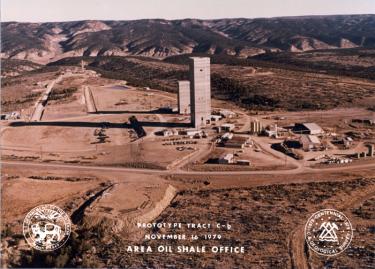
These two distinct approaches produced markedly different impacts on local economic and social arrangements. The relatively small amount of capital investment and its diffusion through numerous small companies in the first boom did not create any boomtowns among the communities of Shale Country, but the second boom was characterized by rapid economic and population growth that engulfed existing communities, creating wholesale disruption that lasted long after the boom ceased. 6
Boomtime Frenzy
As they watched their communities change with the rapid influx of capital and the newcomers it brought, residents of the Western Slope found that a rapid boom can create nearly as much pain and turmoil as a sudden bust.
People from around the nation made the trek to Western Colorado to find work and high boomtime wages. Even if they did not find work at the mines, they could still cash in by building roads, constructing new housing, upgrading old wooden city water lines to handle increased flows, serving meals at suddenly crowded restaurants, and otherwise providing the many requirements that came with transforming small rural towns into a new urban frontier created by oil shale development. 7 Those who did find jobs often did not find housing right away, and semipermanent campgrounds sprung up in and around every town within driving distance of the oil shale fields.
Turnover among workers was frequent. Because construction occurred in phases, the workforce was in constant flux as groups of skilled tradesmen cycled through according to the needs of the projects. Coping with a drastic population increase is difficult enough for the communities caught up in a boom – constantly managing and serving this enormous ebb and flow of transient workers and their families can be overwhelming. Elected officials, longtime locals, and newcomers alike struggled to contend with housing shortages, strained social services, rising crime, overtaxed sanitation systems, insufficient water supplies, pollution, traffic congestion, and noise. 8
Gillette Syndrome
As the small communities caught up in the boom – particularly Parachute (preboom population 300), Rifle (2200), Silt (900), and New Castle (700) – worked to keep from being overwhelmed, they were well supplied with examples of the stakes they faced. The most potent of these examples came from Gillette, a small ranching town on Interstate 90 in Wyoming’s Powder River Basin that sits atop a massive coal seam. Gillette’s boom had started a few years before the oil shale leases were issued, and by 1974 sociologists who studied the town felt they were documenting a public health disaster. “Gillette Syndrome” soon became shorthand for the dark side of energy development.
Researchers identified sharply increased rates of drinking, divorce, delinquency, and depression – dubbed the Four Ds – as the once agrarian town’s population quadrupled from 3000 to 17,000. Although more recent studies have questioned the data supporting these findings, and Gillette today is a community of 40,000 working to transcend its bad rap, the term Gillette Syndrome became a frightening watchword for communities confronting an energy boom. 9
Exxon’s Colony Project
In May 1980, just before Carter signed the Energy Security Act, the stakes on the Western Slope grew even higher when Exxon, the largest company in the world, announced that it had paid $400 million to buy out Atlantic Richfield Company (Arco) and partner with The Oil Shale Company (Tosco) to develop the Colony Oil Shale Project on a 22-square-mile parcel up Parachute Creek. Chevron, Unocal, Mobil, Tennaco, Occidental, and other major energy companies were already developing projects in Shale Country, but Exxon planned to outdo them all. In a now infamous “white paper,” Exxon officials outlined a grand $5 billion vision that proposed digging up to 6 of the world’s largest open pit mines, rerouting water from the Missouri River Basin for shale processing, and ultimately producing 8 million barrels of oil a day by 2010. To accommodate the 22,000 workers Exxon estimated would be required for this extreme scenario, the company planned to build an entirely new town on Battlement Mesa, across the Colorado River from Parachute, with a projected population of 25,000. 10
The commitment of the world’s largest company to oil shale, and the mind-boggling scale of its plans, persuaded even the most skeptical residents of the Western Slope that this time the boom was real. One longstanding local summarized the conflicted feelings many residents had about the new boom, explaining that although oil shale was “badly needed by the nation” and he was patriotically willing to do his part, “I have mixed emotions about what’ll happen to the countryside, and you know they’ll tear up the mountains and add pollution, but on the other hand we need the economic stimulus of industry.” 11
Economic stimulus proved to be a mild term for the ways in which Exxon’s arrival on the Western Slope pushed the boomtime frenzy to new levels. The populations of existing towns mushroomed: Parachute grew from 300 in 1979 to 1200 in 1982 and projections topped out around 15,000. In Rifle, home to 2200 residents before the boom, “modest” projections by the city (geared to a smaller industry than was outlined in the Exxon white paper’s extreme scenario) called for 700 new police and firemen with 140 vehicles, 200 new doctors, and 75,000 new homes within a decade.
Wages and property values soared with the insatiable demand for labor and housing. Carpenters who might have been unemployed or working a minimum wage job ($3.10 in 1980) to make ends meet in Oregon or Ohio earned $16 per hour in Western Colorado, and heavy equipment operators commanded more than $20 per hour, plus per diem travel expenses. In Rifle, the total value of building permits went from a half-million dollars in 1976 to $14 million by 1980. In Grand Junction, the largest city and regional center of the Western Slope, city leaders built a new airport to handle the upsurge in business traffic, a new shopping mall, and 5 new schools to keep pace with the growing population. The establishment of a large-scale oil shale industry seemed so certain that the industry magazine Shale Country began publication again. 12
The Second Bust
Black Sunday and the Legacies of a Failed Policy
And then, on May 2, 1982 – a day known on the Western Slope as “Black Sunday” – everything came to a catastrophic halt. Reckoning with falling oil prices that made oil shale no longer profitable, Exxon’s board of directors announced that they would pull the plug on the Colony Project, effective immediately. The evening news delivered the first word most people in Colorado heard about it. Overnight the 2100 people employed on the project became unemployed, locked out and not even allowed to retrieve their personal effects when they showed up at the job site the next morning. The impact shot through the entire region, leaving everyone from construction workers to bus drivers to area business owners to appraise what a post-shale future might hold for them.
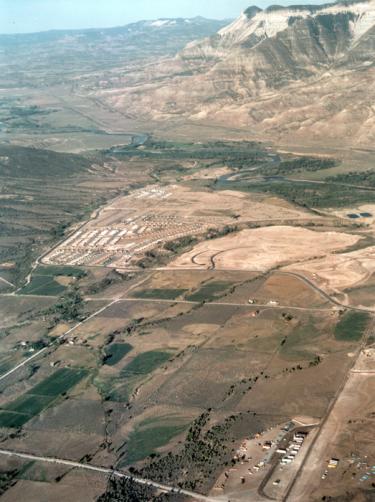
Other energy companies followed Exxon out of town, and approximately $85 million in annual payroll disappeared from the regional economy in just a few years. Many folks read the writing on the wall and didn’t wait around to see what an $85 million vanishing act looked like, quickly deciding that there was no future for them on the Western Slope without the oil shale industry. Within a week of Black Sunday, a thousand people had left Garfield County. There were no more trucks or trailers left to rent.
The exodus continued as nearly 24,000 made their way out of Garfield and Mesa counties between 1983 and 1985 – diminishing the region’s population to less than it had been before the boom – while unemployment on the Western Slope climbed from near zero to 9.5%. Young people departed in search of the wages and opportunities to which they had grown accustomed. Vacancy rates, once nonexistent, topped 14% in Grand Junction, and foreclosures in Mesa County increased from 98 in 1980 to over 1600 in 1985. Office buildings sat vacant. Businesses folded by the score. Banks that had survived the Depression now went under. 13
Although a few companies did stick it out – Unocal and Occidental maintained their operations at limited capacity until the early 1990s, and several other companies, including Shell, continued research and development work on private sites – they were not enough to stem the tide of economic disaster. The oil shale bust triggered a regionwide financial collapse on a scale not seen even in most Midwestern steel towns.14
The first boom failed for lack of capital and inadequate technology, but the second failed primarily due to poorly considered policy. Although there was still no technological breakthrough that made oil shale development profitable, the federal government (with President Carter leading the way) engineered a boom in reaction to the perceived crisis of high oil prices and unstable suppliers. Energy companies followed the government’s lead, responding to government incentives with major investments of their own.
Oil money and federal subsidies pumped unprecedented amounts of capital into Shale Country during the 1970s and ’80s, but it was not enough to purchase the necessary technological innovation (nor was it clear that such a breakthrough was available for purchase at any price). When oil prices normalized again, neither the government nor private industry could continue to justify sustained investment. Taxpayers and energy companies had spent untold billions with negligible returns, but the residents of the Western Slope bore the brunt of the failed policy’s cost.
Notes:
1 Russell, History of Western Oil Shale, 103-7; Wasko, “A Look at Shale Country – January 1981,” 5.
2 Russell, History of Western Oil Shale, 117-8; P.A. Petzrick, “Oil Shale – An Ace in the Hole for National Security,” Shale Country (Oct 1975): 18-9; Alys Novak, “Oil Shale – 1976: Review/Preview,” Shale Country, 5. A joint bid of $210.3 million from Standard Oil Company of Indiana and Gulf Oil Corporation won tract C-a. Tract C-b was leased for $117.8 million by a consortium of companies that included Atlantic Richfield (Arco), Ashland Oil, Shell Oil, and TOSCO. In Utah, the U-a tract went to a partnership of Sun Oil and Phillips Petroleum for $75.6 million, and U-b was let to the White River Shale Oil Corporation for $45.1 million. No bids were received for the two less-rich tracts offered in Wyoming (Russell). Both Colorado leases were relinquished in the 1990s.
3 The mood in Shale Country during this time was the topic of numerous articles, including year-in-review pieces published in Shale Country just before it suspended publication and first thing after it came back. See Wasko, “A Look at Shale Country – January 1981,” 5-6; Novak, “Oil Shale – 1976: Review/Preview,” 4-9; “Shale Spins Off Unique Legacy” (editorial statement), Shale Country (Dec. 1976): 1.
4 Gulliford, Boomtown Blues, 93-103. Carter’s speech, given at the White House on 18 April 1977, is widely available. The exact amount allotted for the Synthetic Fuels Corporation is hard to pin down; sources range from $12-20 billion, the discrepancies presumably a result of variable funding mechanisms.
5 Andrus v. Shell Oil Co. 446, U.S. 657 (1980); Gulliford, Boomtown Blues, 61-2. The earlier ruling cited by the court was the Secretary of Interior’s decision in the 1927 case of Freeman v. Summers.
6 Gulliford, Boomtown Blues, 46; Patricia Nelson Limerick, William Travis, and Tamar Scoggin, Boom and Bust in the American West (Boulder, CO: Center of the American West, 2002), 9 (PDF).
7 “Urban frontier” is a term popularized by Duane Smith, who showed in his book Rocky Mountain Mining Camps: The Urban Frontier, 1860-1901, (Niwot, Colorado: University Press of Colorado, 1967) that the rapid growth of the towns that sprang up around mineral rushes gave them an urban character distinct from more rural farming and ranching communities elsewhere in the West. Although Smith was writing about nineteenth-century boomtowns, the thesis seems clearly applicable to modern scenarios as well. See also: Duane Allan Smith, “Mining Camps: Myth vs. Reality,” Colorado Magazine 44, no. 2 (1967): 93-110.
8 Gulliford, Boomtown Blues, 90-2; Patricia Nelson Limerick, Claudia Puska, et al, What Every Westerner Should Know About Energy (Boulder, CO: Center of the American West, 2002), 18 (PDF).
9 Andrew Gulliford, “The Tiger Empties the Tank: The Oil Shale Boom-and-Bust in Colorado,” Journal of the West 28, no. 4 (1989): 22; Limerick, What Every Westerner Should Know About Energy, 18-19 (PDF). The original paper, entitled “Social Consequences of Boom Growth in Wyoming” (PDF), was presented by El Dean Kohrs at the 1974 meeting of the Rocky Mountain Section of the American Association for the Advancement of Science, although it was never formally published. For an example of the questions since raised about the legitimacy of Gillette Syndrome, see James G. Thompson, “The Gillette Syndrome: A Myth Revisited?” Wyoming Issues 2, no. 2 (1979): 30-5(PDF); Kenneth P. Wilkinson et al, “Local Social Disruption and Western Energy Development: A Critical Review” Pacific Sociological Review 25, no. 3 (July 1982): 275-96 (PDF). For additional information, Michael S. Coburn has compiled a wealth of data and research on his Sublette County Socioeconomics website.
10 Gulliford, “The Tiger Empties the Tank,” 22-3; Gulliford, Boomtown Blues, 88, 113, 121-3. Although it was circulated around the Western Slope at the time, including at a meeting sponsored by Club 20 in July in Grand Junction, the Exxon white paper, which was officially titled “The Role of Synthetic Fuels in the United States Energy Future,” is now difficult to get ahold of. Understandably, the company is not eager to share this printed faux pas, and we have relied here on Andrew Gulliford’s rendering of it, which is no doubt accurate but perhaps not cast in the most sympathetic light.
11 Robert Wamsley, retired schoolteacher, Rifle, CO, quoted in Gulliford, Boomtown Blues, 13.
12 Information in these paragraphs about the boom’s projected impact on the Western Slope after Exxon’s arrival is drawn from: Gulliford, Boomtown Blues, 111-34; Limerick, What Every Westerner Should Know About Energy, 19 (PDF); US Department of Labor, Employment Standards Administration, “History of Federal Minimum Wage Rates Under the Fair Labor Standards Act, 1938 – 2007”; “Shale Country: Born Again,” Shale Country (Jan. 1981): 1-2.
13 Gulliford, Boomtown Blues, 153-94; Congressional Testimony by Jim Evans, Executive Director Associated Governments of Northwest Colorado, “A Local Government Perspective on Federal Oil Shale Research and Development Efforts,” before the Senate Committee on Energy and Natural Resources Washington, D.C. (12 April 2005); Nicholas Lemann, “Grand Junction Can’t Win for Losing,” Atlantic Monthly 255, no. 18 (April 1985): 18-28. In his Senate testimony, Jim Evans, then Executive Director of the Associated Governments of Northwest Colorado, noted that “At the peak of the cycle, the combined population of the 2 most impacted counties (Garfield and Mesa) increased from 1981 to 1983 by 12%, from 112.0 thousand to 125.6 thousand. Then in the next 2 years the combined population dropped back to 111.8 thousand.”
14 Congressional Testimony By Jim Evans, Executive Director Associated Governments of Northwest Colorado, “A Local Government Perspective on Federal Oil Shale Research and Development Efforts,” Before the Senate Committee on Energy and Natural Resources Washington, DC (12 April 2005); Nicholas Lemann, “Grand Junction Can’t Win for Losing,” Atlantic Monthly 255, no. 18 (April 1985): 18-28.


